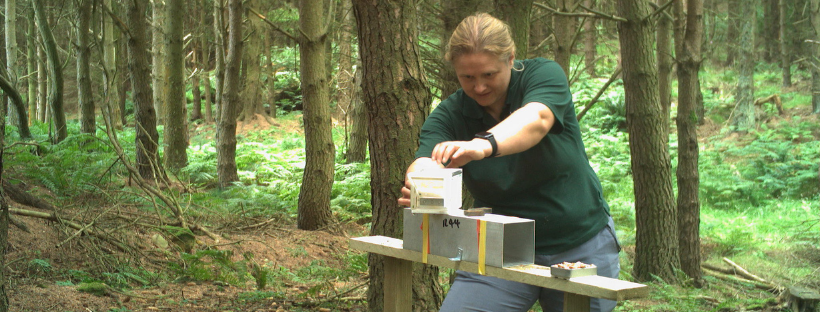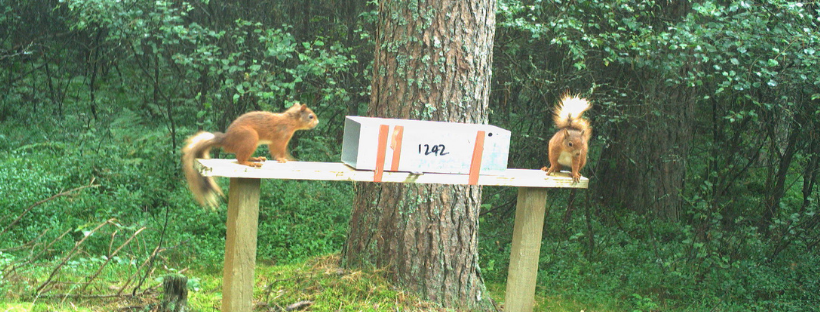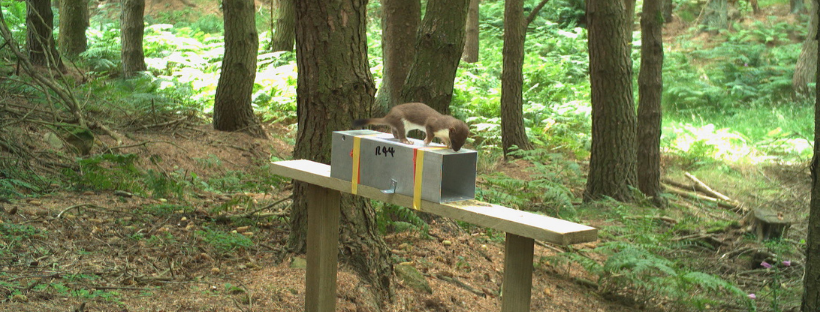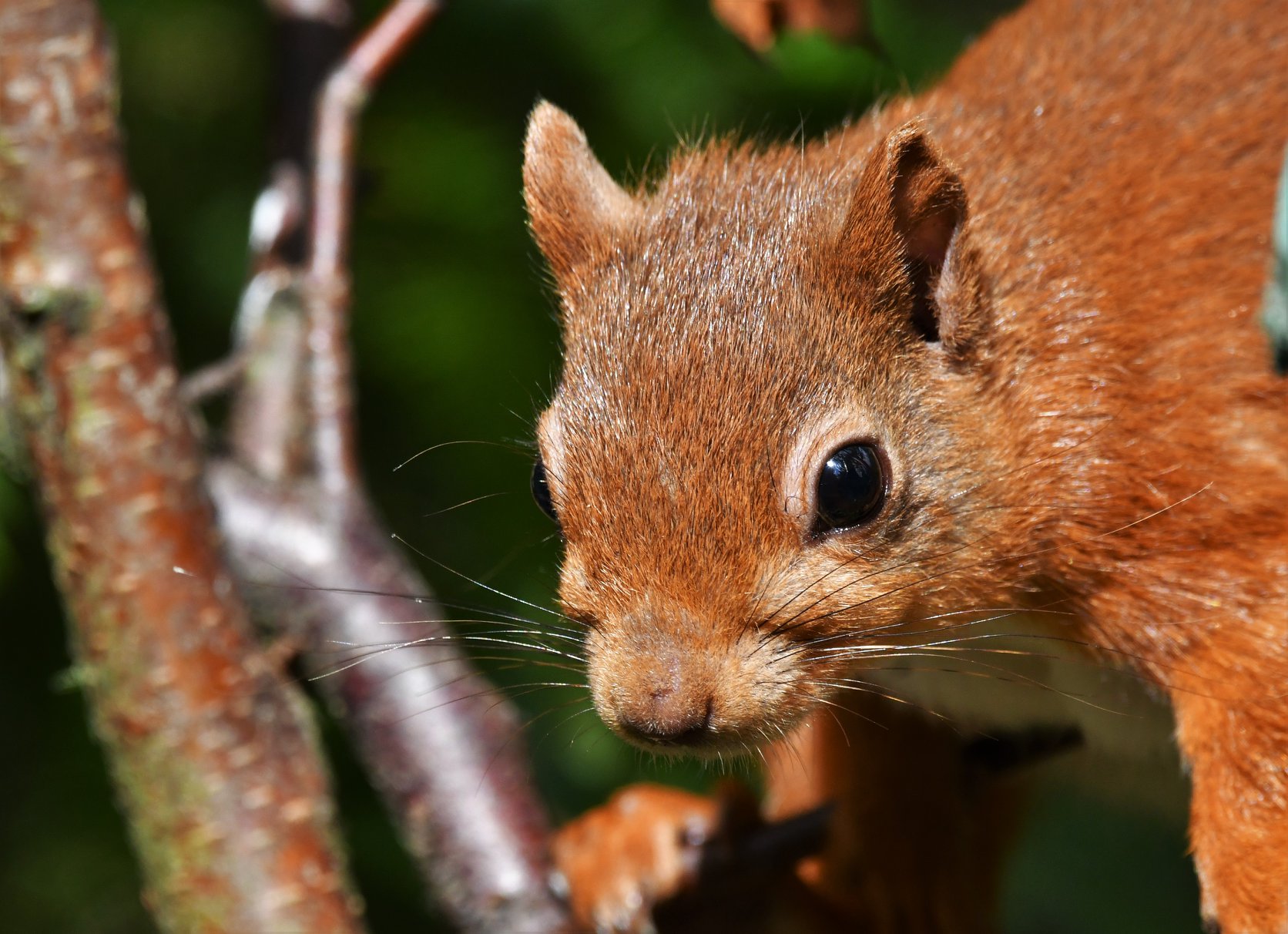Developing a grey squirrel feeder for targeted contraceptive delivery

How can an oral contraceptive be fed to 2.5 million grey squirrels? Research to develop an oral contraceptive for grey squirrels is now entering its fourth year. As these contraceptives may affect other mammals, one of the most important parts of the research is to design a bait hopper that only grey squirrels can feed from. This is a summary by researcher Sarah Beatham on some of the work carried out with Northumberland red squirrel community groups this summer, to test if red squirrels and other animals could be prevented from feeding from the hoppers.

The feeding hopper was co-developed with NatureCounters. It collects data such as numbers of feeding visits by individual squirrels and amount of bait taken per visit. This provides greater insight into grey squirrel behaviour and enables optimisation of bait uptake by squirrels that will contain a contraceptive.
Our field studies have tested hoppers with a 70 g door that has to be pushed open by the head of an animal to access the bait. Each time the door is lifted, the date and time is recorded automatically. Identification of the species that have lifted the door can be done using a remote camera set to take photos and videos.
Several field trials have been carried out in woods in Yorkshire and North Wales. Besides the thousands of grey squirrels recorded, only one mouse has been seen entering a hopper. Based on previous research by Forest Research, for this study, we decided to test door weights of 200 g and 240 g, to see if they would prevent red squirrels and other animals, apart from grey squirrels, from feeding on the bait.

Field trials summer 2021
Trials were conducted in two areas of Northumberland, near Wooler and Otterburn. Two woods were chosen that are known to have good populations of red squirrels but no grey squirrels. Two friendly and knowledgeable groups of volunteers assisted with deploying the equipment, baiting the hoppers and checking the remote cameras.
Work was carried out in late July when ten hoppers were deployed across both woods. Each hopper was fixed to a 1-metre-high stand and monitored by a remote camera. Five hoppers in each wood were fitted with a novel colour sensor device positioned at the entrance, which recorded the colour of the red squirrel coats. The colour data will be used to test if there is a detectable difference between red and grey squirrel coats and could be used to exclude red squirrels from hoppers.
Initially, the hopper doors were tied open to encourage red squirrels and other animals to feed freely from a mixture of sunflower seeds, peanuts and hazelnut paste (that the red squirrels found irresistible). The bait was replenished four times in 10 days. The doors were then closed and fitted with 200 g weights on one site and 240 g on the other. The bait inside the hoppers was replenished three times in the first week and the weight of the bait consumed on each visit was recorded. The following week, the weights were swapped between each site and the trial was repeated.

Results to date
During the two-week trial, 16,000 photos and videos were taken of animals around the hoppers. The vast majority of these were of red squirrels, but mice, stoats and small birds, such as nuthatch, great tit and robin, were also recorded entering the hoppers while the doors were tied open.
In both woods, the red squirrels quickly started to feed from the hoppers and when both door weights were added, they were visibly deterred and frustrated, swishing their tails in annoyance. However, some tenacious red squirrels persisted and managed to lift the doors.
The only other animal that managed to lift the weighted doors, with some struggle and on only a few occasions at one site, were stoats; although it is unlikely that they consumed the bait. Red squirrel coat colour data was collected from hundreds of visits from different squirrels at both woods, which will be compared with grey squirrel colour data in future trials.

Progress and thanks
This study provided important benchmark data from which to progress the research into developing a feeder for grey squirrels only. Work will continue to exclude red squirrels from the hoppers, but this study has provided further evidence most UK wildlife can be excluded using a simple and cost-effective design. In practice, this means the hoppers could be used safely in areas where there are no red squirrels, which are large areas where grey squirrels have outcompeted and removed red squirrels.
It was a joy to work on this study and lovely to be out in beautiful surroundings with other people who are also passionate about red squirrel conservation. This was also the final field trial planned for my PhD, so represents an important personal milestone.
Many thanks to the Wooler Red Squirrel Group and the volunteers at Otterburn for all their hard work during the trials, to the Woodland Trust for providing funding for this particular part of the overall study and the UK Squirrel Accord for their continued support. Find out more about the fertility control research.
Sarah Beatham is a wildlife ecologist at the Animal & Plant Health Agency, with over 12 years’ experience of wildlife management research. Sarah is currently in the fourth year of a part-time PhD at Durham University, ‘Developing and implementing novel methods for managing populations of grey squirrels.’
Read Sarah’s blog post from last year’s field trials and see her presentation from the fertility control research update recorded earlier this year. Donate to help us complete this important research.



